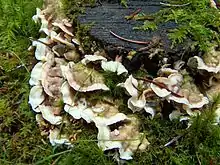Skeletocutis amorpha
Skeletocutis amorpha is a species of poroid fungus in the family Polyporaceae, and the type species of the genus Skeletocutis.
| Skeletocutis amorpha | |
|---|---|
 | |
| Scientific classification | |
| Kingdom: | |
| Division: | |
| Class: | |
| Order: | |
| Family: | |
| Genus: | |
| Species: | S. amorpha |
| Binomial name | |
| Skeletocutis amorpha | |
| Synonyms[1] | |
| |
Taxonomy
The fungus was first described as new to science in 1815 by Elias Magnus Fries as Polyporus amorphus. It has since acquired an extensive synonymy.[1] Czech mycologists František Kotlába and Zdeněk Pouzar transferred it to the genus Skeletocutis in 1958.[2]
Description
Fruit bodies are effused-reflexed (crust-like with the edges curled out into rudimentary caps), or, more rarely, completely crust-like.[3]
Its spores are allantoid (sausage-shaped), and measure 3–4.5 by 1.3–1.8 μm.[3]
Habitat and distribution
A widely distributed fungus, S. amorpha is found in Africa, Australia, China,[4] and Europe. It causes a white rot in the dead wood of various species of the pine family, particularly pine, but also fir, larch, and spruce. Rarely, it grows on hardwoods such as alder, beech, and oak.[3]
References
- "GSD Species Synonymy: Skeletocutis amorpha (Fr.) Kotl. & Pouzar [as 'amorphus']". Species Fungorum. CAB International. Retrieved 2016-10-29.
- Kotlába, F.; Pouzar, Z. (1958). "Polypori novi vel minus cogniti Cechoslovakiae III" (PDF). Ceská Mykologie (in Czech). 12 (2): 95–104.
- Ryvarden, Leif; Melo, Ireneia (2014). Poroid Fungi of Europe. Synopsis Fungorum. 31. Oslo, Norway: Fungiflora. p. 392. ISBN 978-8290724462.
- Dai, Yu-Cheng; Cui, Bao-Kai; Huang, Ming-Yun (2007). "Polypores from eastern Inner Mongolia, northeastern China". Nova Hedwigia. 84 (3–4): 513–520. doi:10.1127/0029-5035/2007/0084-0513.